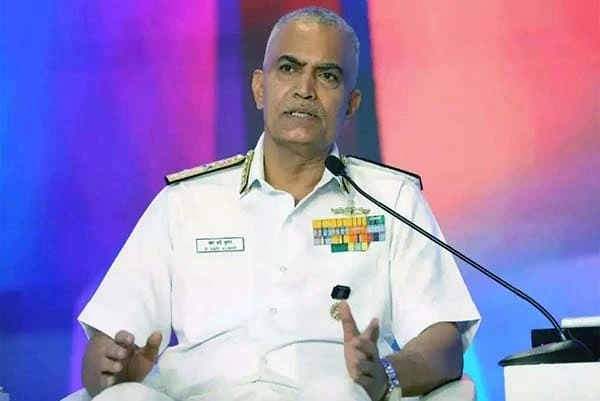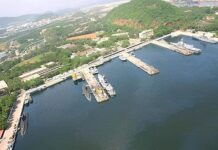The annual apex-level international conference of the Indian Navy – the Indo-Pacific Regional Dialogue (IPRD) – was held in New Delhi on 15-17 November 2023. The IPRD followed the Goa Maritime Conclave 2023, which had been conducted by the Indian Navy from 29 to 31 Oct 2023 in Goa.
While the Goa Maritime Conclave sought to project the Indian Navy’s cooperative engagement at the strategic-operational level, by providing a forum for the Chiefs-of-Navy and Heads of Maritime Agencies in the Indian Ocean Region, the IPRD, on the other hand, was the principal manifestation of the Navy’s international engagement at the strategic-level, addressing ‘holistic’ maritime security issues across the Indo-Pacific.
The first two editions of IPRD were held in 2018 and 2019 respectively at New Delhi. IPRD 2020 was cancelled due to the Covid-19 outbreak. The third edition of IPRD was held in 2021 in online mode and the fourth edition was conducted, reverting to a physical format, at New Delhi in 2022.
Theme of IPRD-2023
The overarching theme of IPRD-2023 was “Geopolitical Impacts upon Indo-Pacific Maritime Trade and Connectivity”. This year’s edition of the IPRD built upon the previous one, which focussed upon ‘Operationalising the Indo-Pacific Oceans Initiative (IPOI)’, by specifically addressing the ‘Trade, Connectivity and Maritime Transport’ pillar of the IPOI.
IPRD-2023 explored geopolitical impacts upon Indo-Pacific maritime trade and connectivity through six professional sessions spread over a three-day period.
The sessions were:
Nodes of maritime connectivity;
China’s impact vis-à-vis maritime connectivity across the Indo-Pacific;
Maritime connectivity through shipping and trade;
Maritime connectivity through shipping and trade (Part 2);
Private industry in the safety and security of Indo-Pacific maritime trade and shipping; and
Maintaining a rules-based, safe, and secure Indo-Pacific.
Eminent speakers from 16 countries and representatives of the various embassies and high commissions attended and offered diverse regional perspectives on the subject.
Navy Chief’s Address
Speaking at the Indo-Pacific Regional dialogue organised by the Indian Navy, navy chief Admiral R Hari Kumar said that violations of established rules pose a danger to good order at sea. He described the security situation in the South China Sea as “fragile.” He warned that the region is the most militarised in the world and a “contestation” at sea can have adverse economic and social consequences.
“The fragile security situation in the South China Sea, in addition to the happenings of violations of established codes of conduct or confidence building measures, pose a clear and present danger to good order and discipline at sea,” Admiral Kumar said.
The comments were a rare direct reference to the situation in the South China sea and come at a time when China and Pakistan are undertaking large-scale naval drills in the Arabian Sea.
He said that more than 50 warships of extra regional forces are deployed in the Indian Ocean Region on various missions, including anti-piracy patrols off the Gulf of Aden and the wider Indo-Pacific has a significant naval presence, which can lead to confrontation and contestation.
“Owing to the increased presence of multinational forces, and differing interpretations of international laws, there is this fear that the region’s ‘global commons’ can change to ‘contested seas’,” he said. The navy chief added that this contestation at sea “can have adverse consequences for security-physical, social as well as economic”.
Admiral Kumar made a case for greater collaboration between nations in the maritime nation. “We are traversing through a contested present into an uncertain future. The future of global commons hinges on cooperative efforts of nations,” he said.
He said that cooperative or collaborative systems amongst like-minded maritime nations are essential for a stable future. He also made a strong case for developing interoperability and trust between nations, saying this requires a sustained and continued engagement.
Chinese Threat
China’s People’s Liberation Army Navy (PLAN) presents the greatest challenge to the Indian Navy in the Indo-Pacific region. The PLAN is supported by the China Coast Guard and the Chinese maritime militia in furthering Chinese national interest in the Indo-Pacific region.
China’s friendship with Pakistan is of concern as they together present a new challenge to India in the maritime domain. India considers the Indian Ocean region as the key to India’s security and also aims to build credibility in the Indo-Pacific.
The dispute over Taiwan and China’s aggressive posture in the South and East China Seas, and China’s rivalry with America for dominance in those waters has brought the Indo-Pacific region centrestage. China’s ‘grey zone’ operations against US maritime forces and its allies have further sharpened rivalries in the Indo-Pacific.
India’s Linkages with the Indo-Pacific
The Indian government’s has often enunciated a vision of a free, open, inclusive, and prosperous Indo-Pacific.
The Indo-Pacific is the gateway to the Indian Ocean from the east with crucial trade and security implications. Hence its is of vital interest to India as also to ASEAN countries. India has linkages with many countries of southeast Asia and east Asia. The Indian Navy has been exercising with navies of the ASEAN region for many years. The Malabar series of exercises include participation by the United States navy and Japanese Self Defence Forces. Ther Indian Navy has exercised not only in the Bay of Bengal but in the western Pacific as well.
India’s ‘Look East’ policy was enunciated in the early 1990s, keeping in mind its maritime and security interests. The same has transformed into ‘Act East’ policy. In pursuit of this policy, the Indian Navy has engaged its counterparts in the Indo-Pacific by way of maritime military cooperation and humanitarian assistance and disaster relief.
Piracy, maritime terrorism, maritime crimes like drug and human trafficking, are some of the other threats which the Indian Navy has to be deal with. Other non-traditional threats include climate change-induced sea-level rise and maritime pollution. State actors in particular are challenging the rules-based, liberal international order and need to be dealt with.
Indian Navy’s Approach
The Indian Navy provides maritime security for safe trade and monitors vessels that enter or leave the Indian Ocean region through the Malacca Strait, with the Andaman and Nicobar Command’s undertaking regular surveillance. Coordinated naval patrols with Bangladesh, Thai and Indonesian navies have been institutionalised. Maritime partnership exercises are conducted with Singapore, Thailand, Indonesia, Malaysia and Myanmar, in bilateral or multilateral formats.
Indian naval ships, submarines and aircraft have undertaken long-range overseas deployments, across the Indo-Pacific as far as Japan, Hawaii and Australia.
Towards becoming a net security provider in the region, the Indian Navy has been helping smaller maritime neighbours and providing platforms and equipment for their navies. Neibhbours have appreciated India’s help in training, repairs, expertise in hydrography, maritime surveys and cartographic assistance.
The Indian Navy is the first responder in the region for humanitarian assistance and disaster relief. In the aftermath of the 2004 tsunami, earthquakes, cyclones, and pandemics the Indian Navy’s contribution with relief supplies with professionalism has created yremendous goodwill.
Comments
The Indo-Pacific region stretches from the coastlines of East Africa to the western Americas. It is today a vital oceanic space comprising critical chokepoints that carry a majority of the world’s trade. The chokepoints are situated at key geopolitical flashpoints. The Indo-Pacific is now perceived as vital for energy security, maritime security, and maritime commerce. The Indian Navy is is a formidable and potent force to provide such security in the region.
The Indian Navy is preparing a 175-ship plan (25 ships more than its current strength of 150) to particularly deal with the Chinese threat in the Indian Ocean.
India has strategic partnership with the United States, Japan, South Korea, Australia, Southeast Asian countries, and West Asian countries. India is also involved in the Quadrilateral Security Dialogue (QUAD) featuring three partners in the US, Japan, and Australia.
The Indian Navy is playing an important role in realising the Indian government’s vision of a free, open, inclusive, and prosperous Indo-Pacific.


















